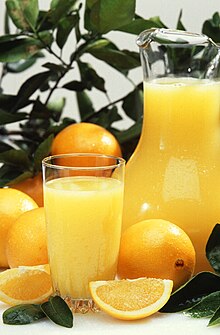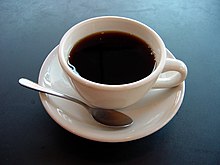Drink: Difference between revisions
| [pending revision] | [pending revision] |
AntiSpamBot (talk | contribs) BOT--Reverting edits by 89.26.225.172 to revision 133180624 (cocktailteam\.net) |
|||
| Line 60: | Line 60: | ||
==External links== |
==External links== |
||
*[http://www.cocktailteam.net/default.aspx CocktailTeam.net] |
|||
{{commons|Beverages|Drink}} |
{{commons|Beverages|Drink}} |
||
*[http://news.bbc.co.uk/2/hi/health/5281046.stm Tea healthier drink than water] |
*[http://news.bbc.co.uk/2/hi/health/5281046.stm Tea healthier drink than water] |
||
Revision as of 20:13, 27 May 2007
The word drink is primarily a verb, meaning to ingest liquids. As a noun, it refers to the liquid thus ingested. It is often used in a narrower sense to refer to alcoholic beverages (as both a verb and a noun). Drink is also slang for a body of water, such as an ocean or a water hazard on a golf course (e.g. "He hit that one into the drink."). To drink in is also used metaphorically, as in to drink in the scenery.
A beverage is a drink specifically prepared for human consumption, except water. Beverages almost always largely consist of water. Water is essential for living, significantly more so than food. Death will usually occur after one week without any liquids but humans have been known to survive some months without food.
Types of drinks
Water
Essential to the survival of all organisms,[1] water has historically been an important and life-sustaining drink to humans. Excluding fat, water composes approximately 70% of the human body by mass. It is a crucial component of metabolic processes and serves as a solvent for many bodily solutes. Health authorities have historically suggested at least eight glasses, eight fluid ounces each, of water per day (64 fluid ounces, or 1.89 L),[2][3] and the British Dietetic Association recommends 1.8 liters.[1] The United States Environmental Protection Agency has determined that the average adult actually ingests 2.0 L per day.[3] Water is available in several forms. Nearly all other drinks, including juice, soft drinks, and carbonated drinks, have some some form of water in them. Distilled (pure) water is rarely found in nature.[4] Spring water, a natural resource from which much bottled water comes, is generally imbued with minerals. Tap water, delivered by domestic water systems in developed nations, refers to water piped to homes through a tap. All of these forms of water are commonly drunk, often purified through filtration.[5]


Alcoholic beverage
- Alcoholic beverages (which see for classification).
- Non-alcoholic variants
- Low alcohol beer
- Non-alcoholic wine
- Sparkling cider
- Non-alcoholic variants

Hot beverages
- Hot beverages, including infusions. Sometimes drunk chilled.
- Coffee-based beverages
- Cappuccino
- Coffee
- Espresso
- Frappé
- Flavored coffees (mocha etc.)
- Iced coffee
- Latte
- Hot chocolate
- Hot cider
- Mulled cider
- Glühwein
- Tea-based beverages
- Herbal teas
- Roasted grain beverages (Postum etc.)
- Coffee-based beverages
Other
Some substances may either be called food or drink, and accordingly be eaten with a spoon or drunk, depending on solid ingredients in it and on how thick it is, and on preference:
Trivia
- Latenight talk show host David Letterman has often said, "There isn't a man, woman or child alive who doesn't enjoy a tasty beverage."
See also
External links
Notes and references
- ^ a b Greenhalgh, Alison (2001). "Healthy living - Water". BBC Health. Retrieved 2007-02-19.
{{cite web}}: Unknown parameter|month=ignored (help) - ^ "The Benefits of Water". Cleveland Clinic. Retrieved 2007-02-19.
- ^ a b "Chapter 3, Exposure Scenario Selection" (PDF). EPA. 2000. pp. p. 8. Retrieved 2007-02-19.
{{cite web}}: Unknown parameter|month=ignored (help) - ^ "Water Links". Center for Science in the Public Interest. Retrieved 2007-02-19.
- ^ "Brief History of Drinking Water". American Water Works Association. 2007. Retrieved 2007-02-19.
